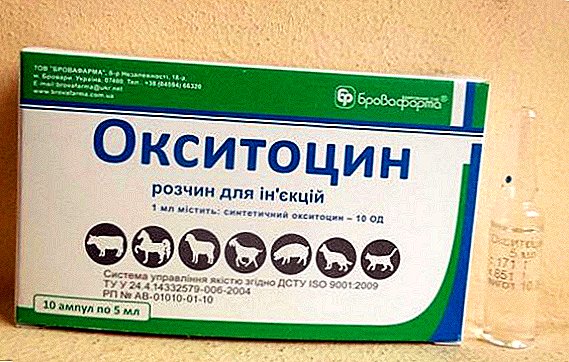 Childbirth is one of the most important life processes of any living organism. Genus continuation is genetically inherent in man and in animal. Half a century ago, mortality during childbirth was several times higher than today.
Childbirth is one of the most important life processes of any living organism. Genus continuation is genetically inherent in man and in animal. Half a century ago, mortality during childbirth was several times higher than today.
One of the reasons for this progress is the use of modern medicines. Moreover, this trend concerns not only medicine, but also veterinary medicine. Today we will talk about the veterinary drug "Oxytocin", which can help with childbirth, both your pet and farm animals.
Composition and release form
Oxytocin - A hormone produced by the hypothalamus and accumulating in the pituitary gland. The hormone is actively involved in lactation and helps reduce uterine muscles, which contributes to childbirth.
The drug oxytocin is its artificial counterpart. The preparation, in addition to synthetic oxytocin, includes water and methylparaben. Available in ampoules of 2, 5, 10 and 20 ml or 50 and 100 ml bottles.
1 ml of solution contains 5 or 10 units of oxytocin. 
Pharmacological properties
Oxytocin is classified as hormones and, in some situations, as their antagonists. It provokes a contraction of the smooth muscles of the uterus. Promotes lactation and childbirth. The main component increases the tone of the uterus in mammals, especially in late pregnancy, stimulates childbirth.
Indications for use
Indications for use of oxytocin are as follows:
- weak during labor;
- very low tone of the uterus or its absence;
- lactation in an animal;
- inflammation of the mammary glands;
- uterine bleeding;
- inflammation of the internal mucosa of the uterus;
- delayed exit of the placenta.
For the treatment of certain pathologies of the genital organs in animals, veterinarians often use the synthetic hormone drug Sinestrol.
Order of use and dose
The instructions for use say that oxytocin is administered intravenously, subcutaneously or intramuscularly. Possible option of injection of the drug in combination with novocaine, although this method in veterinary medicine is used infrequently.  It is better to apply means by intramuscular administration of drug. The only drawback of such an introduction - the drug consumption is twice the flow rate for epidural administration.
It is better to apply means by intramuscular administration of drug. The only drawback of such an introduction - the drug consumption is twice the flow rate for epidural administration.
The rule of dosage for different methods of administration is as follows.: If subcutaneous or intramuscular administration of the agent is taken as a basis, the dosage for epidural administration will be 1/2 of the recommended intramuscular dose.
Intravenous injection - 2/3 from intramuscular. The dosage is in units (IU). The result from an intramuscular injection occurs within 2 minutes, the intravenous drug is effective after 30-60 seconds.
Did you know? The cows have their close friends, the tenderness for which is expressed in affectionate licking each other.
Mares and cows
For cattle and horses, the usual dose for subcutaneous (intramuscular) administration is 30-60 units. Accordingly, when administered intravenously - 40 IU, and together with novocaine, you need to enter from 15 to 30 units of solution.
Read also about the breeds of cows: Red Steppe, Jersey, Kalmyk, Highland, Aberdeen-Angus, Brown Latvian, Shorthorn, Kholmogory, Ayrshire, Simmental, Holstein, Yaroslavl, Kazakh.
Goats and sheep
It is recommended for goats and sheep to inject 10-15 IU agents under the skin or into the muscle, and 8-10 units when injected into a vein. Epidural goats, sheep and dogs do not administer the drug. 
Sows weighing up to 200 kg
For a sow, the dose will be 30 units intramuscularly, 20 - into the vein, and 10-15 when injected with novocaine.
Check out useful tips on breeding sheep, goats, horses, rabbits, chinchillas, nutria.
Dogs
For dogs, oxytocin is prescribed mainly when insufficient attempts. Experienced dog breeders are extremely cautious about using the product, and they recommend that you give an injection only after the first puppy and before the last one. The dosage for females is as follows:
- intramuscularly (subcutaneously) - 5-10 IU;
- intravenous - 2-7 IU.
Epidural to dogs is not administered.
Cats
Cat Dosage: 3 units under the skin, intravenously or epidurally - 2 IU.  A cat is recommended to be given oxytocin not only during childbirth, but also after it. A few words about how to do this. After birth, 0.3 ml of the drug is administered 2 times a day, for three days, this will help lactation and clean the uterus.
A cat is recommended to be given oxytocin not only during childbirth, but also after it. A few words about how to do this. After birth, 0.3 ml of the drug is administered 2 times a day, for three days, this will help lactation and clean the uterus.
Important! With the introduction of oxytocin along with glucose, the effect of the drug action comes faster.
Security and Personal Care Measures
The drug belongs to low-hazard substances. But, as in the case of the use of any medication, it requires compliance with certain rules.
After application, wash your hands with detergent. If swallowed, seek medical advice. It is advisable to have an annotation to the veterinary drug.
Contraindications and side effects
Contraindications to the use of the drug a little. Here are the main ones:
- individual intolerance;
- incorrect position of the fetus, which can cause hypoxia and rupture of the cervix;
- the inability to give birth naturally;
- physical abnormalities of the fetus, its inconsistency with the size of the mother's pelvis.

Did you know? In the human body, oxytocin is a hormone responsible for the feelings of affection, caring and pleasure of communication.If no individual intolerance is observed, and the norms of reception are observed, side effects usually not detected. Otherwise, they can manifest themselves as follows:
- heart rhythm disorder;
- spasms of muscle tissue of the bronchi;
- a sharp short decline in blood pressure;
- sharp tension of smooth muscles of the uterus;
- allergy.
Important! Large doses of oxytocin retain urine in the body, while increasing its concentration, but reducing the volume.
Overdose can cause lack of oxygen and lead to fetal death. The therapeutic measures in this case are as follows:
- decrease in the volume of fluid;
- the use of diuretics, electrolytes and pressure-increasing NaCl solution.
Shelf life and storage conditions
Store the drug must be in a sealed package at a temperature + 1 ° C… + 15 ° Cin a dry, dark place out of the reach of children. Shelf life - 24 months. The remains of the drug is not used, they must be disposed of. Do not use after the expiration date.
Oxytocin is a powerful drug. Do not make a decision on its use independently. There are many nuances that can lead to the death of an animal (fetal position, the impossibility of normal delivery, the risk of uterine rupture). Be sure to consult a veterinarian. Only a specialist is able to give the right recommendations.












